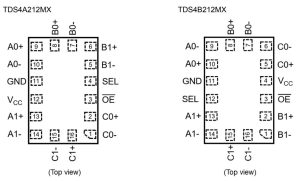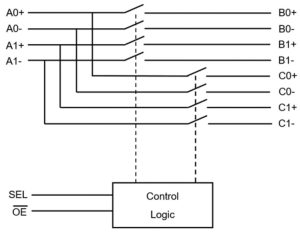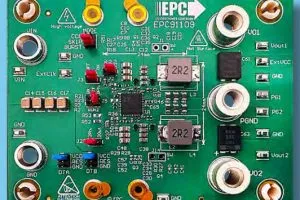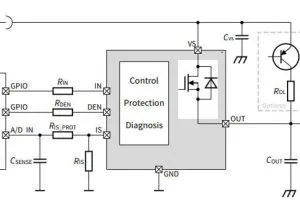The devices are aimed at high speed serial busses including PCIe 5.0/4.0, CXL 2.0/1.0, USB4 Version 2.0, Gen3/Gen2, USB 3.2 Gen 2/Gen 1, Thunderbolt 4, DisplayPort 2.0/1.4 and SAS 3.0.

Made on the company’s ‘TaRFSOI’ silicon-on-insulator CMOS process, both parts have the same switch, and same 2.4 x 1.6 x 0.4mm XQFN16 package, but pinouts are different (right) to optimise the parts for different applications.
TDS4A212MX’s is optimised for easy board layout, its differential specs are:
-3dB Bandwidth 26.2GHz
Insertion loss -1.1dB (10GHz), -1.9dB (16GHz)
Return loss -17dB (10GHz), -18dB (16GHz)
Off isolation -17dB (10GHz), -11dB (16GHz)
Crosstalk -32dB (10GHz), -30dB (16GHz)
TDS4B212MX is optimised for high frequency performance, its differential specs are:
-3dB Bandwidth 27.5GHz
Insertion loss -0.9dB (10GHz), -1.4dB (16GHz)
Return loss -20dB (10GHz), -16dB (16GHz)
Off isolation -16dB (10GHz), -14dB (16GHz)
Crosstalk -44dB (10GHz), -36dB (16GHz)
 When switching, port A is connected to either port B or port C, controlled by the SEL input, and all switches are high-impedance if OE is held high regardless of SEL, dropping consumption to 10μA max.
When switching, port A is connected to either port B or port C, controlled by the SEL input, and all switches are high-impedance if OE is held high regardless of SEL, dropping consumption to 10μA max.
Operation is over -40 to 85°C and 1.6 to 3.6V, and enabled consumption is typically 60μA (150μA max).
Signals can vary across 0 to 2V common-mode and up to 1.8V differentially.
Propagation delay of the faster (…B…) part is typically 30ps, bit-to-bit skew is 4ps and channel to channel skew is 2ps.
It takes a maximum of 100μs from power-up or output-enable for the outputs to be valid, and SEL turns a port ‘on’ in a maximum of 180ns, and ‘off’ in 18ns max. Output disable takes 21ns max.
Use is expected expanding peripheral devices in PCs, in servers and in mobile devices.
Web pages
 Electronics Weekly
Electronics Weekly



